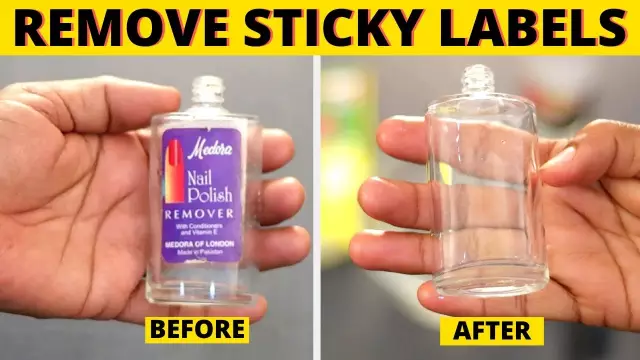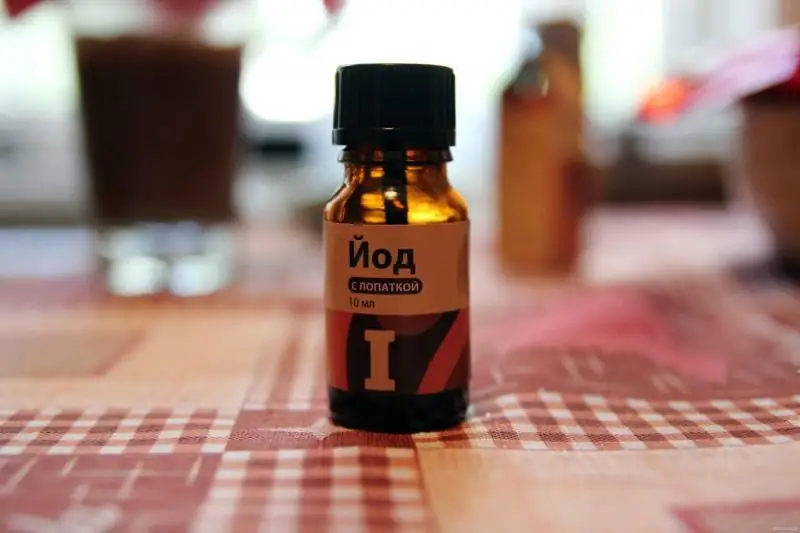
Table of contents:
- Author Bailey Albertson [email protected].
- Public 2023-12-17 12:53.
- Last modified 2025-01-23 12:41.
How to remove silicone sealant from different surfaces

Silicone sealant is a necessary thing in the household. They fill up the seams between the tiles, seal the joints between the bathroom and the wall, close up small gaps. During construction and renovation, you cannot do without it. Therefore, it is often necessary to remove the sealant from the surface when replacing, or got on it by negligence.
Content
- 1 Is the sealant harmful
- 2 What will help wash off the sealant
-
3 How to remove stains from different surfaces
-
3.1 Leather
3.1.1 Video: how to wash your hands from the adhesive with salt
- 3.2 Clothing
- 3.3 Hard surfaces (glass, tile, enamel bath)
-
3.4 Plastic surfaces (panels, pipes, acrylic bathtub, shower cubicle)
3.4.1 Video: how and with what to wash silicone sealant from different surfaces
-
3.5 Car
- 3.5.1 Video: How to remove silicone sealant from a car surface
- 3.5.2 Video: how to clean the headlights from the sealant
- 3.6 Laminate
- 3.7 How to clean the sealant gun after use
-
- 4 Things to avoid
- 5 How to protect from stains
- 6 User feedback on different ways to remove sealant
Is the sealant harmful
Silicone itself is completely harmless to both skin and surfaces. It is enough to remember that baking trays and molds for baking confectionery are made from it.

After hardening, the silicone sealant is resistant to most physical and chemical influences
Another thing is that the sealant does not consist of pure silicone. A distinction is made between one-component and two-component sealants. In everyday life, only one-component are used, which are divided by chemical composition into two groups:
- acidic ones have a strong acetic smell and an inexpensive price, they contain acetic acid;
- neutral ones are made on the basis of alcohol or ketoxime, they are more expensive than acidic ones, they have almost no smell.
And although the complete safety of the formulations is declared, some ingredients can cause an allergic reaction. Especially if the sealant is cheap and the manufacturer has saved on quality ingredients.
Acidic sealants interact with metal, cementitious and some other materials, causing them to corrode. In addition, the sealant poses a hazard to painted surfaces with good adhesion, but only if it must be removed from that surface. Together with the sealant, there is a risk of removing the top paint layer.
What will help wash off the sealant
There are several ways to solve the problem:
- mechanical;
- chemical;
- combined.
The mechanical method requires the application of force and sharp tools or abrasives
What can be used:
- construction or office knife;
- blade;
- screwdriver;
- scraper;
- putty knife;
- sandpaper;
- eraser;
- salt.
All protruding sealant is cut off from the surface with a knife, the remains are removed with sandpaper or other abrasive substance, rubbing the contaminated surface. The method is only applicable to hard, scratch-resistant surfaces.
The chemical method involves the use of special agents and solvents. These include:
-
special silicone cleaners (Penta-840, Dow Corning OS-2);

Silicone cleaner Special cleaners designed for different surfaces
-
White Spirit;

White Spirit White spirit is the most effective remedy for silicone sealant
- solvent R-646;
- petrol;
- kerosene;
- diesel fuel;
- acetone;
- acetic acid.
Combined combines mechanical and chemical. First, the main part of the sealant is cut off, then the residues are removed with a solvent.
The choice of method depends on the material of the surface, its hardness and resistance to chemical attack. The composition of the sealant is also important: acidic ones are better removed with acetic acid, neutral ones - with alcohol.
How to remove stains from different surfaces
As with any stains, it is best to remove the sealant before it is dry. This is done with a cloth moistened with plain water without the use of additional agents. Dry stains are much more difficult to remove.

Carelessness in work can lead to sealant stains
Leather
In hardware stores, special wipes are sold to remove traces of glue, sealant and other compounds. They will solve the problem quickly and safely for the skin. For lack of special tools, use the help.
Table salt will help remove silicone from the skin. If your hands are stained, take a salt bath.
- In a bowl, combine 2 tablespoons of salt and a glass of warm water.
- Dip your hands into the solution and hold for 10-15 minutes.
- Rub the stains with a loofah or a hand washing brush, the silicone film will peel off easily.
It is not necessary to make a saline solution. You can moisten the skin with warm water, then rub the stained area with salt, the silicone flakes off. This method works for other areas of the body as well.
Video: how to wash your hands from the adhesive with salt
An ingenious way is with a plastic bag. Crumple the bag and roll it around in your soiled hands. The sealant will stick to the polyethylene and will easily come off the skin. All that remains is to wash your hands with soap and water.
The sealant is removed from the face and body with warmed vegetable oil. Lubricate the stain and leave it on for a while. You can attach an oiled tissue to the area. Remove the softened mass with a cloth, rubbing slightly.
Take a hot bath and scrub the stains with a washcloth. With warmed up damp skin, the sealant will wash off much easier.
clothing
Try to remove fresh but already dried stains from clothes by stretching the fabric. The adhesion of the substance to the fibers will decrease and it can be easily removed by picking up the edge and pulling.
For dried-on dirt, use the method used to remove the gum. Place the garment in the freezer, then pry off the edge and remove the sealant.
If the mass has penetrated into the fibers, proceed as follows:
- Stretch the fabric over the jar or bowl, stain side up.
- Using a knife, carefully cut the mass as close to the fabric as possible.
- Treat residues with 70% acetic acid, alcohol, mineral spirits or other solvents and allow the substance to soften.
- Soak clothing in soapy water.
- Hand wash.
Hard surfaces (glass, tile, enamel bath)
The method depends on the layer thickness. Bulk beads are cut off with a sharp knife or blade, the remains are processed mechanically or chemically.

The tiles are cleaned first mechanically and then chemically
With the mechanical method, it is important that the abrasive or scraper material is softer than the surface to be treated, otherwise scratches will remain. Use a knife, putty knife, sandpaper, salt, or eraser.

On hard surfaces, residues are removed with a scraper
The chemical method involves the use of solvents and chemicals. It can be a professional remover: Penta-840, Dow Corning OS-2 and others. Such products are subdivided according to the type of surface to be treated, pay attention to this when buying.
From the usual means used white spirit, acetic acid, alcohol, gasoline, kerosene.
- Moisten the stains with solvent and wait until they soften.
- Remove the rest with a cloth.
- Degrease the surface with alcohol or vodka.
To soften the non-heat-resistant sealant, you can use a regular or construction hair dryer. Under the influence of high temperature, the silicone will flow and will only have to be wiped off with a cloth.
Plastic surfaces (panels, pipes, acrylic bathtub, shower cabin)
The adhesion of the sealant to plastic is weaker than to other materials. It doesn't take much effort to remove it. It is enough to moisten the stains with a solvent, wait 30-60 minutes and rinse off the remains with a rag moistened with a degreasing liquid.
The same method will help if the composition got on the vinyl wallpaper. Vinyl is also plastic.
Video: how and what to wash silicone sealant from different surfaces
Car
Sagging from the surface of the car is removed with a rag dipped in gasoline, kerosene or diesel fuel. Moisten a rag and treat the smudges, they will wash off easily.
Video: how to remove silicone sealant from a car surface
Use vegetable oil to clean the headlights. Moisten the beads liberally and wait until they soften. Remove residues with a knife or spatula. Do not forget to degrease the surfaces after processing.
Video: how to clean the headlights from the sealant
Laminate
Both mechanical and chemical methods are suitable for floor coverings. Consideration should be given to the hardness and resistance of the coating to chemical attack in order not to damage them.
- The beads are cut with a knife as close to the surface as possible.
-
The remains are cleaned with a damp cloth with coarse salt.

Salt Salt is used as a mild abrasive to remove the sealant
For inconspicuous areas, you can use sandpaper or powder abrasive.
Safe for the surface, you can erase the residue with an eraser. It will take a lot of time, but the coverage will not suffer.
A quick result is achieved by using professional formulations. Choose a product that is suitable for this particular coating, the information is indicated on the package.
Alcohol, white spirit, acetone, and other solvents can be used. Acetic acid and other acids will damage the finish.
Professionals advise treating like with like. A fresh coat of sealant is applied to dried spots so that the contours line up with the spot. Wait for the substance to soften the hardened layer, controlling the process with a toothpick. After that, pry the mass off the edge and remove from the surface.
How to clean the sealant gun after use
There is nothing complicated in this, the pistol is freed from all unnecessary mechanically with a knife. Cut off sagging, scrape off the rest. Any solvent can be used.
What to avoid
- Do not use solvents on varnished and painted surfaces, they will damage and discolor the coating.
- The use of acids and alkalis on metal objects will lead to corrosion.
- Abrasives and sharp objects are not suitable for soft surfaces, they will leave scratches.
- Do not use harsh chemicals to remove stains from the skin, you can provoke a burn.
- Do not use strong alkalis on enamelled surfaces (tiles, bathtubs).
- Chemical treatment field, rinse the surface with clean water.
In order not to suffer with silicone stalactites and stalagmites, take precautions when working.
How to protect from stains
- Wear special clothing and gloves to avoid getting the silicone on your skin.
- Cover the floor and other surfaces with plastic or paper.
- Before filling the joint with sealant, cover the contours with masking tape.
- After work, be sure to tighten the cap on the sealant tube.
- Remove excess immediately, do not wait for it to dry.
- Rub the glass with soap, this will help to easily remove smudges in the future.
User feedback on different ways to remove sealant
The problem is not as bad as it seems at first glance. It is enough to put your hands on and apply the knowledge gained in practice and there will be no trace of stains. But if you don't feel like meditating by scraping the silicone off the surface, take care of protecting it from any surprises.
Recommended:
How To Wipe Off The Glue From The Adhesive Tape - Remove Traces Of Ordinary, Double-sided, Painting From Plastic, Furniture, Glass, Clothes And Other Surfaces + Photos And Videos

Everyone uses scotch tape, and sometimes unpleasant traces remain after it. How to wipe off adhesive from plain or double-sided plastic, furniture, glass or clothing
How To Clean A Phone Case (silicone Or Other Material), White Or Other Colors

What materials are phone cases made of? What products can be used to clean silicone, plastic and other materials
How To Wash Hands, Bath, Clothes And Other Objects And Surfaces From Potassium Permanganate

Why is it difficult to wipe off potassium permanganate stains. Effective ways to clean potassium permanganate from hands, clothing, bathtubs, sinks and other surfaces
How To Remove Iodine From Clothes And Other Surfaces, Than To Wash It From The Skin, Various Methods And Means + Video And Photo

How to remove iodine from different fabrics, wash stains from furniture, body and other surfaces. Effective ways with instructions for use with photos and videos
Glass Doors For Saunas And Baths: Varieties, Device, Components, Installation And Operation Features

Glass doors for baths and saunas: types and features of choice. Making a door with your own hands. Installation and operation. Glass door accessories
